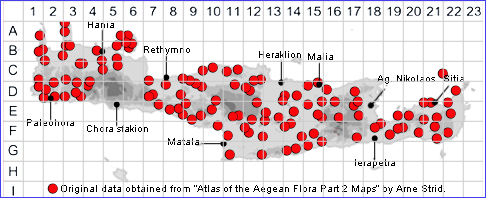SPECIES DESCRIPTION
GENISTA ACANTHOCLADA
Family and Genus:- See- LEGUMINOSAE/Sect. ACANTHOSPARTUM
Common Names:- None
Homotypic Synonyms:- Cytisanthus acanthocladus, Genista acanthoclada,
Genista acanthoclada subsp. graeca, Genista brugnieri, Spartium
acanthocladum, Telinaria acanthoclada.
Meaning:- Genista. Possibly derived from the Celtic, "gen", for a small bush.
Acantho- (L) Thorny-, spiny-.
Clada (Gr) Shoot, branch = Thorny-branch.
General description:- Dense, rigid, much-branched shrub.
Stems:-
1) 40-100 cm tall.
2) Branches, terete, sulcate; twigs transformed into sharp, straight spines.
Leaves:-
1) Small, subsessile, 3-foliolate.
2) Leaflets, linear, appressed-pubescent.
3) Petiole, pulvinate at the base.
Flowers:-
1) Solitary, short-pedicellate in the axils of leaf-like or simple bracts.
2) Calyx, c. 3 mm, campanulate, 2-lipped, puberulent,
a) lips, almost as long as the tube.
3) Corolla, 8-10 mm, bright yellow,
a) standard, somewhat shorter than the keel, both sericeous.
Fruit:-
1) Legume, ovoid, acuminate, appressed-pubescent, sericeous, 1-seeded.
Key features:-
1) Branches, opposite.
2) Leaves, 3-foliolate.
3) Petiole, pulvinate at the base.
Habitat:- An important constituent of open dry shrubby vegetation, scrubland
vegetation and as under-growth of open coniferous woodland. 0-1200 m.
Distribution:- Common in S & E Greece. Also in W & S Anatolia and Cyenenaica.
Widespread and common on Crete.
Flowering time:- Apr-June
Photos by:- Dr. Armin Jagel

